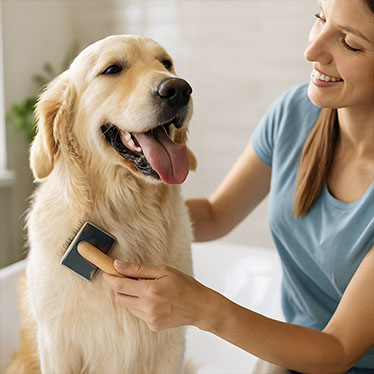
Regular grooming isn’t just about keeping your dog looking good—it’s essential for their health and comfort. While professional grooming is great, dog grooming at home can be just as effective and much more budget-friendly with the right tools and routine. It also builds trust and helps you spot early signs of health concerns like skin issues, fleas, or ear infections.
If you’re not sure where to start, don’t worry. This guide walks you through safe, effective ways to groom your dog at home, including brushing, bathing, trimming nails, and cleaning ears.
🧼 Why Dog Grooming at Home Matters
Dogs need routine grooming to prevent matting, ear infections, and overgrown nails. Home grooming allows you to monitor your dog’s skin, coat, and overall condition regularly. It’s especially helpful for dogs who are nervous around strangers or can’t visit the groomer often due to health issues or schedule limitations.
At Qualified Pet Services, we always recommend incorporating small grooming habits into your pet’s weekly routine. Even short sessions—like brushing or wiping paws—can make a big difference in your dog’s comfort.
🪥 Must-Have Tools for At-Home Grooming
Here are a few essentials you’ll want to have on hand:
- Dog-specific brush suited to your dog’s coat type
- Pet-safe shampoo (never use human shampoo)
- Nail clippers or grinder
- Cotton balls and dog ear cleaner
- Towels and a non-slip mat for bath time
- High-value treats for rewards
Look for tools labeled as safe for dogs and avoid anything that causes visible discomfort or irritation.
🛁 Step-by-Step Guide to Basic Dog Grooming at Home
1. Brushing
Brush your dog 2–3 times a week. Long-haired breeds may need daily brushing to prevent mats. Use a slicker brush or comb suitable for their coat.
2. Bathing
Most dogs only need a bath every 4–6 weeks. Use lukewarm water, rinse thoroughly, and avoid getting soap in the eyes and ears.
Helpful product guide: AKC’s best dog shampoos
3. Nail Trimming
Trim nails every 3–4 weeks. Cut small bits at a time to avoid the quick (the pink part inside the nail).
This guide from the ASPCA offers great visuals if you’re new to it.
4. Ear Cleaning
Use a vet-recommended ear cleaning solution and cotton balls. Never use cotton swabs. Clean only what you can see, and stop if your dog resists.
5. Teeth Brushing
While not grooming per se, brushing your dog’s teeth 2–3 times a week helps prevent dental disease. Use only dog-formulated toothpaste.
🐶 Keep It Calm and Rewarding
Grooming should be a positive experience. Start slow, use lots of praise, and take breaks if your dog seems stressed. Break grooming into smaller steps across different days if needed. You can even incorporate parts of your home grooming routine into your dog’s enrichment time.
If your dog shows signs of fear or aggression during grooming, it may be worth working with a vet or professional trainer first. Not all grooming has to be DIY—our trained pet care team can help with light grooming needs during pet visits.
📚 References:
- American Kennel Club. (n.d.). Best Dog Shampoos. Retrieved August 31, 2025, from https://www.akc.org/expert-advice/health/best-dog-shampoos/
- ASPCA. (n.d.). Dog Grooming Tips. Retrieved August 31, 2025, from https://www.aspca.org/pet-care/dog-care/dog-grooming-tips
- PetMD. (n.d.). How to Groom Your Dog at Home. Retrieved August 31, 2025, from https://www.petmd.com/dog/general-health/how-groom-dog-home
⚠️ Disclaimer:
Qualified Pet Services is not liable for injuries, allergic reactions, or complications resulting from grooming tools or techniques used at home. Always consult your veterinarian before starting a new grooming routine, especially if your dog has medical conditions.


